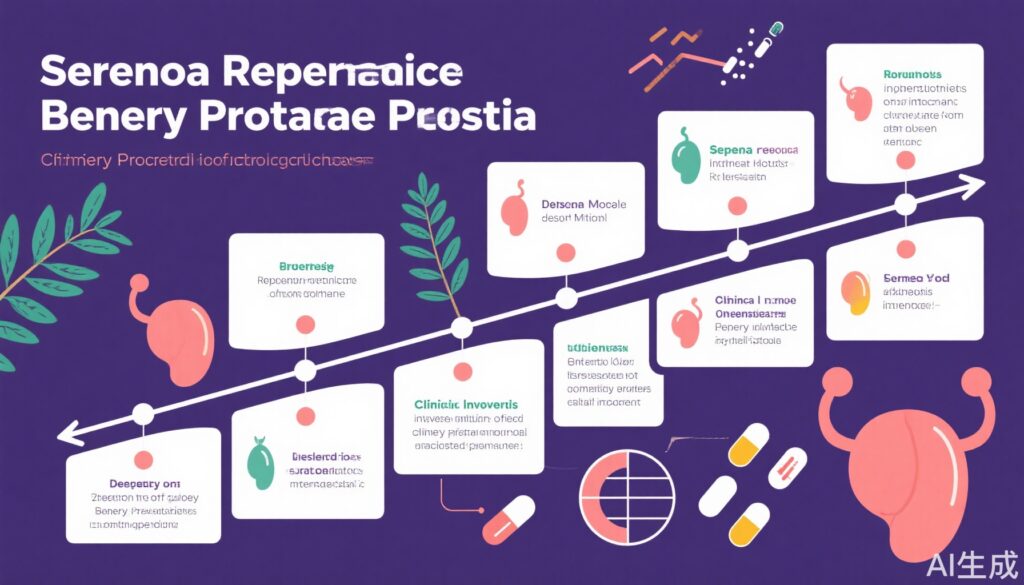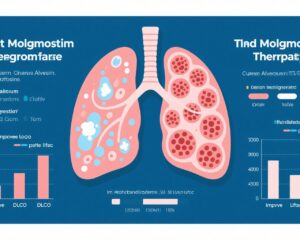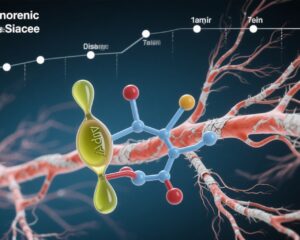Highlights
- Standardized Serenoa repens extracts, particularly hexanic extracts like Permixon®, show modest efficacy in improving lower urinary tract symptoms (LUTS) and quality of life in men with benign prostatic hyperplasia (BPH).
- Clinical benefits include improvements in International Prostate Symptom Score (IPSS), peak urinary flow rate, nocturia, and some inflammatory markers, with a favorable safety profile.
- Evidence from rigorous randomized controlled trials (RCTs) shows varied results; some large trials do not confirm superiority over placebo, but meta-analyses suggest small to moderate effects.
- Combination therapies involving Serenoa repens with selenium, lycopene, or alpha-blockers may enhance symptom control compared to monotherapy.
Background
Benign prostatic hyperplasia (BPH) is a highly prevalent condition among aging men, characterized by lower urinary tract symptoms (LUTS) such as urinary frequency, urgency, nocturia, and weak stream. These symptoms substantially impair quality of life. Medical management includes α-blockers, 5α-reductase inhibitors (5ARIs), and phytotherapeutic agents such as Serenoa repens (saw palmetto extract), which is widely used despite mixed evidence concerning efficacy. Understanding the clinical utility, safety, and potential mechanisms of action of Serenoa repens is vital for informed therapeutic decisions.
Key Content
Chronological Development and Clinical Trial Evidence
Early studies in the 2000s evaluated lipidosterolic extracts of Serenoa repens (e.g., Permixon). A 2003 randomized controlled trial (RCT) (PMID 12887481) reported no significant difference in IPSS or urinary flow rate compared to placebo over 12 weeks. The same year, an open pilot study (PMID 14572753) demonstrated that Permixon markedly reduced inflammatory cytokines (TNF-alpha, IL-1beta) and IPSS, supporting anti-inflammatory effects.
A meta-analysis conducted in 2004 (PMID 15049985) encompassing 14 RCTs and 3 open-label trials (N=4280) indicated that Permixon significantly improved IPSS by approximately 4.78 points versus placebo and increased peak urinary flow rate by 1.02 mL/s, alongside reducing nocturia. The heterogeneity was notable, with some long-term studies showing less pronounced effects.
Subsequent RCTs assessing dose escalation or long-term treatment (up to 72 weeks) suggested no additional benefits over placebo (PMID 22551330) with some trials failing to find superiority even at triple doses.
More recent high-quality RCTs from China (PMID 30880074) and India (PMID 32620155) using standardized hexanic extracts or β-sitosterol-enriched saw palmetto oils confirmed statistically significant improvements in IPSS, peak flow rates, and androgen deficiency scores over 12 to 24 weeks, supporting efficacy in target populations.
Systematic Reviews and Meta-Analyses
An updated meta-analysis in 2018 (PMID 29694707) compiling data from 27 studies (N=5800) demonstrated that hexanic extract Serenoa repens (HESr) significantly reduced nocturia by 0.64 voids/night (95% CI -0.98 to -0.31; P<0.001) and increased maximum urinary flow rate by 2.75 mL/s (95% CI 0.57 to 4.93; P=0.01) compared to placebo. Its efficacy was comparable to α-blockers like tamsulosin and short-term 5ARIs, with no adverse impacts on sexual function or prostate-specific antigen (PSA) levels.
Comparative and Combination Therapy Studies
Clinical trials have compared Serenoa repens-based combinations (with selenium and lycopene) against tadalafil 5 mg, reporting non-inferiority in improving IPSS and Qmax with fewer adverse effects (PMID 29569389). Another Italian multicenter double-blind RCT (PROCOMB trial, PMID 25154739) demonstrated that combination therapy of Serenoa repens, selenium, lycopene, and tamsulosin afforded superior improvements in IPSS and urinary flow over monotherapies across 12 months, indicating synergy.
Mechanistic Insights and Biomarker Studies
Serenoa repens influences prostatic apoptosis pathways, increasing the Bax:Bcl-2 expression ratio and caspase-3 activity, which may underpin clinical improvement (PMID 15643230). Additionally, anti-inflammatory effects were observed clinically via reduced expression of inflammatory genes and proteins such as MCP-1/CCL2, IP-10/CXCL10, and MIF after treatment with hexanic extract (PMID 26306400), correlating with symptom improvement.
Safety and Tolerability
Across multiple trials including the extensive CAMUS trial (PMID 23063633), Serenoa repens demonstrated an excellent safety profile, with no greater adverse events than placebo, even at doses up to three times the conventional level over 18 months. Importantly, serum PSA levels remained unaffected (PMID 23253958), alleviating concerns about interference with prostate cancer screening.
Use in Chronic Prostatitis and Pelvic Pain Syndromes
Evidence for efficacy in chronic bacterial prostatitis is limited but promising when used adjunctively with antibiotics and other supplements (PMID 25038794). Multimodal regimens incorporating duloxetine, α-blockers, and saw palmetto improved symptom indices and psychological status in chronic pelvic pain (PMID 24231216), though saw palmetto alone lacked sustained benefit in CP/CPPS (PMID 14665895).
Expert Commentary
The clinical utility of Serenoa repens remains nuanced. While early enthusiasm was tempered by trials showing no superiority over placebo, especially at short durations or with non-standardized extracts, higher-quality trials and meta-analyses indicate modest but statistically significant improvements in LUTS and quality of life. The anti-inflammatory and pro-apoptotic mechanisms provide plausibility for clinical effects, particularly for hexanic extracts.
Guidelines generally position Serenoa repens as an option with favorable safety for patients seeking phytotherapy or those intolerant to standard pharmacotherapy. Combination therapies with micronutrients or α-blockers may enhance clinical outcomes. Nevertheless, due to variability in study designs, formulations, and populations, definitive recommendations require cautious interpretation.
Limitations include heterogeneous extract preparations, varied dosing regimens, and some conflicting evidence from large well-controlled placebo trials. Standardization of extracts and longer follow-up trials are essential for clear clinical conclusions.
Conclusion
Serenoa repens, especially hexanic extracts such as Permixon®, provides a relatively safe and well-tolerated option with modest efficacy in improving LUTS associated with BPH. It reduces nocturia, enhances urinary flow, and may modulate prostatic inflammation and apoptosis. Combination regimens appear promising for enhanced symptom control. Further large-scale, long-term RCTs with standardized phytotherapeutic products are warranted to confirm clinical benefits and define optimal patient selection.
References
- Dwivedi S et al. A double blind, placebo-controlled randomized comparative study on the efficacy of phytosterol-enriched and conventional saw palmetto oil in mitigating benign prostate hyperplasia and androgen deficiency. BMC Urol. 2020;20(1):86. doi:10.1186/s12894-020-00648-9. PMID: 32620155
- Fang J et al. Efficacy and Safety of Serenoa repens Extract Among Patients with Benign Prostatic Hyperplasia in China: A Multicenter, Randomized, Double-blind, Placebo-controlled Trial. Urology. 2019;129:172-179. doi:10.1016/j.urology.2019.02.030. PMID: 30880074
- Stevenson C et al. Efficacy and safety of a hexanic extract of Serenoa repens (Permixon) for the treatment of lower urinary tract symptoms associated with benign prostatic hyperplasia (LUTS/BPH): systematic review and meta-analysis of randomised controlled trials and observational studies. BJU Int. 2018;122(6):1049-1065. doi:10.1111/bju.14362. PMID: 29694707
- Porcaro AB et al. Serenoa repens + selenium + lycopene vs tadalafil 5 mg for the treatment of lower urinary tract symptoms secondary to benign prostatic obstruction: a Phase IV, non-inferiority, open-label, clinical study (SPRITE study). BJU Int. 2018;122(2):317-325. doi:10.1111/bju.14209. PMID: 29569389
- Debruyne FM et al. Updated meta-analysis of clinical trials of Serenoa repens extract in the treatment of symptomatic benign prostatic hyperplasia. BJU Int. 2004;93(6):751-6. doi:10.1111/j.1464-410X.2003.04735.x. PMID: 15049985
- Kabashima A et al. Effects of hexanic extract of Serenoa repens (Permixon 160 mg) on inflammation biomarkers in the treatment of lower urinary tract symptoms related to benign prostatic hyperplasia. Prostate. 2015;75(16):1857-67. doi:10.1002/pros.23059. PMID: 26306400
- Kumar R et al. Chronic bacterial prostatitis: efficacy of short-lasting antibiotic therapy with prulifloxacin (Unidrox) in association with saw palmetto extract, lactobacillus sporogens and arbutin (Lactorepens). BMC Urol. 2014;14:53. doi:10.1186/1471-2490-14-53. PMID: 25038794
- Wilt TJ et al. Serenoa repens monotherapy for benign prostatic hyperplasia (BPH): an updated Cochrane systematic review. BJU Int. 2012;109(12):1756-61. doi:10.1111/j.1464-410X.2012.11172.x. PMID: 22551330
- Barry MJ et al. Safety and toxicity of saw palmetto in the CAMUS trial. J Urol. 2013;189(4):1415-20. doi:10.1016/j.juro.2012.10.002. PMID: 23063633


